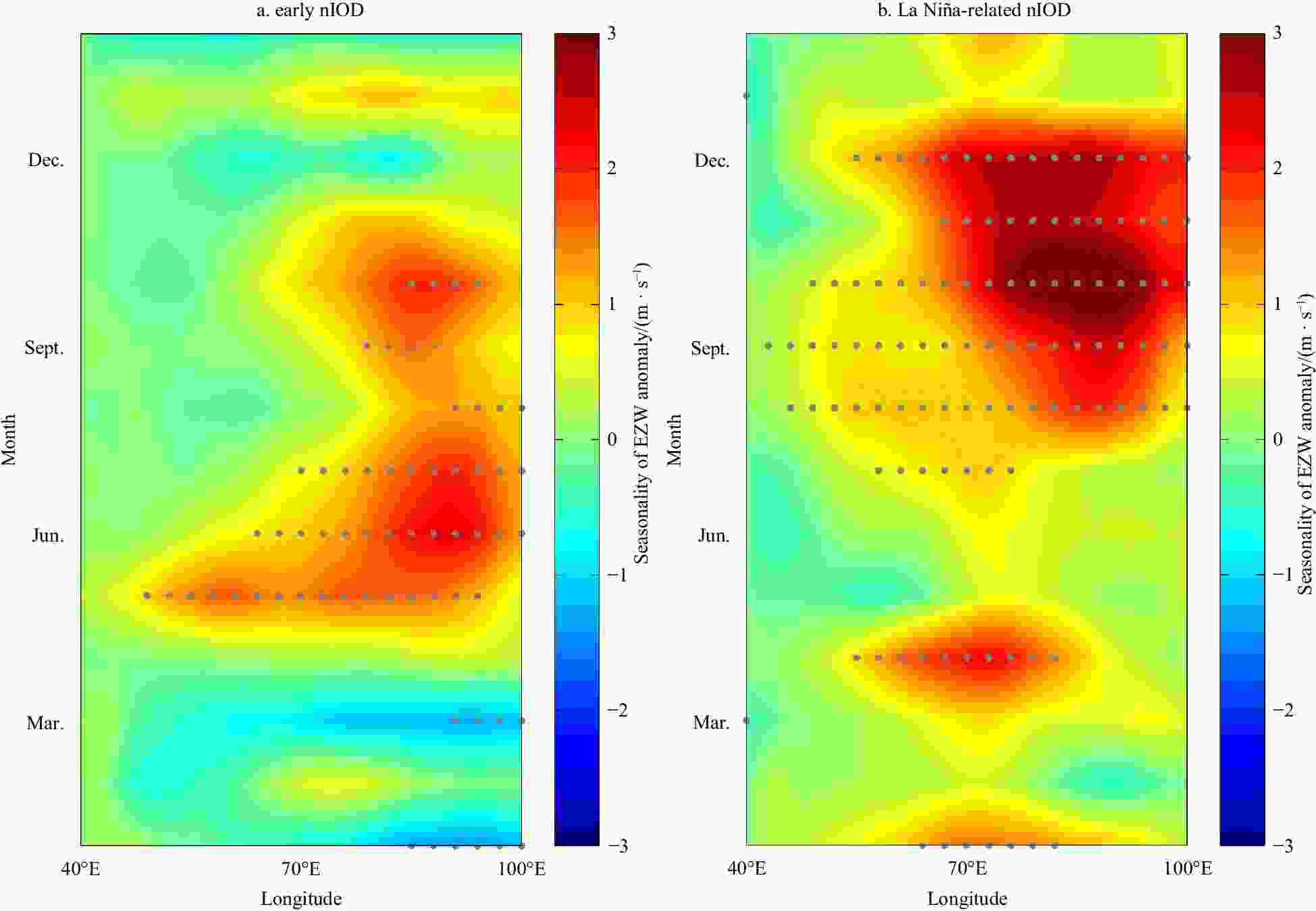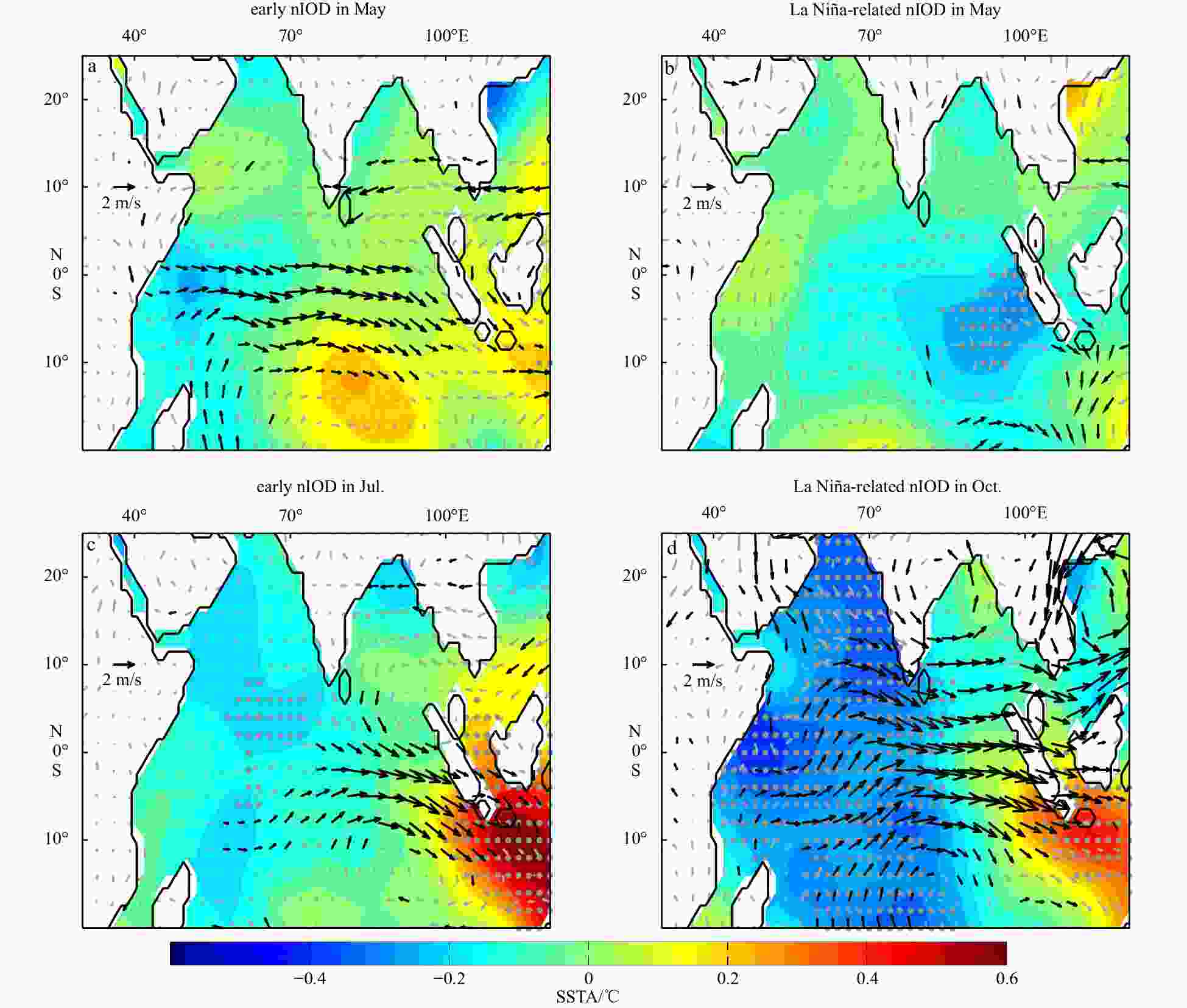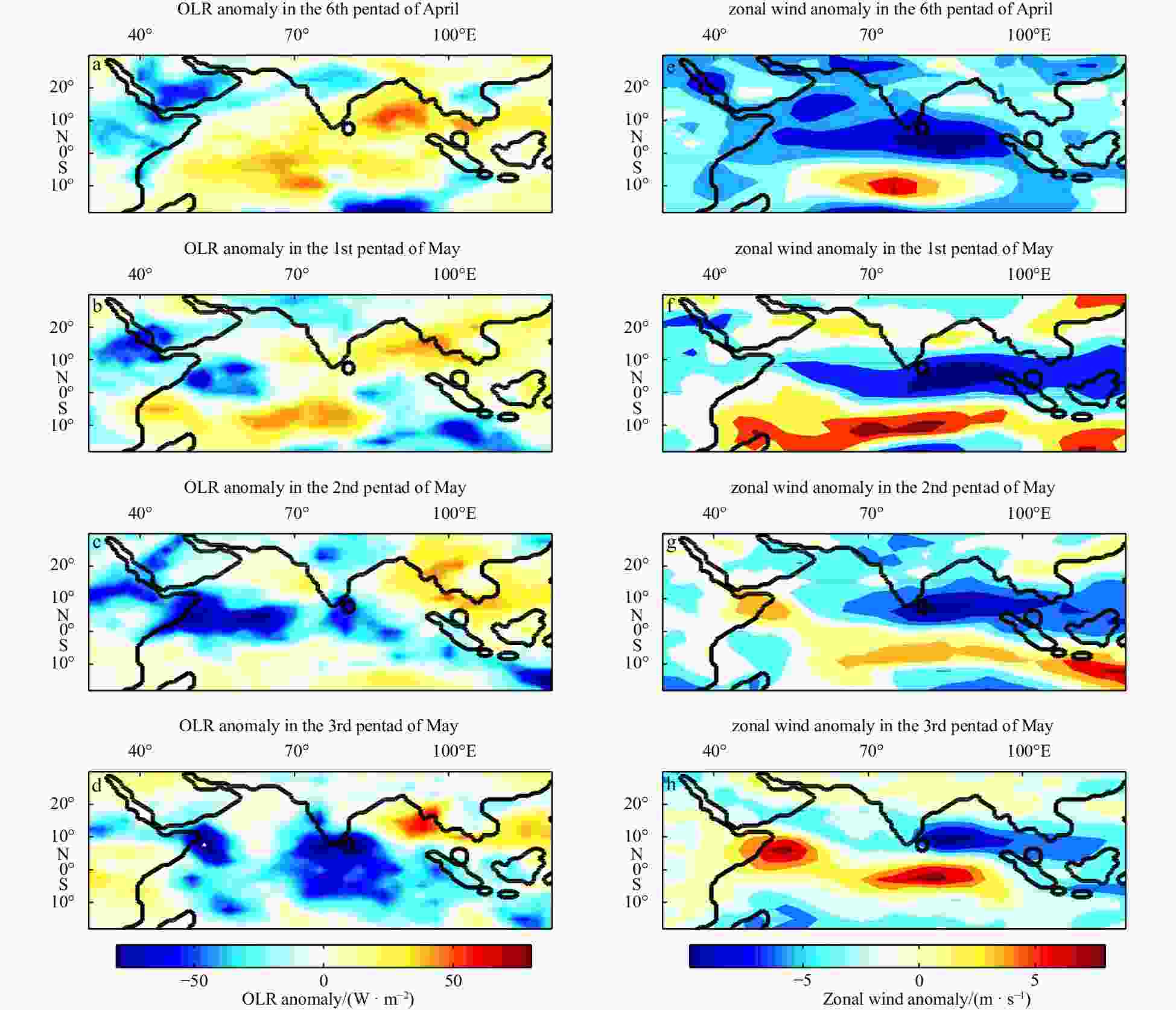-
Abstract: Negative Indian Ocean Dipole (nIOD) can exert great impacts on global climate and can also strongly influence the climate in China. Early nIOD is a major type of nIOD, which can induce more pronounced climate anomalies in summer than La Niña-related nIOD. However, the characteristics and triggering mechanisms of early nIOD are unclear. Our results based on reanalysis datasets indicate that the early nIOD and La Niña-related nIOD are the two major types of nIOD, and the former accounts for over one third of all the nIOD events in the past six decades. These two types of nIODs are similar in their intensities, but are different in their spatial patterns and seasonal cycles. The early nIOD, which develops in spring and peaks in summer, is one season earlier than the La Niña-related nIOD. The spatial pattern of the wind anomaly associated with early nIOD exhibits a winter monsoon-like pattern, with strong westerly anomalies in the equatorial Indian Ocean and eastly anomalies in the northern Indian Ocean. Opposite to the triggering mechanism of early positve IOD, the early nIOD is induced by delayed Indian summer monsoon onset. The results of this study are helpful for improving the prediction skill of IOD and its climate impacts.
-
Key words:
- Indian Ocean Dipole (IOD) /
- triggering mechanism /
- Indian summer monsoon /
- seasonal cycle /
- negative IOD
-
Figure 1. The normalized time series of DMI (averaged during July–October, gray shading). The blue vertical bars indicate La Niña-related nIOD events. The pink bars indicate early nIOD events. The purple bars indicate both types of nIOD appear in the same year. All nIOD events are indicated by blue circles.
Figure 4. Composites of SSTA (°C, color shading) and 850 hPa wind anomalies (m/s, vectors) in May of early nIOD (a) and La Niña-related nIOD (b), in the peak month (July) of early nIOD (c) and in the peak month (October) of La Niña-related nIOD (d). Wind vectors and SSTA values that exceed the 90% confidence level are shown in black arrows and gray dots, respectively.
-
Cai Wenju, Santoso A, Collins M, et al. 2021. Changing El Niño-Southern Oscillation in a warming climate. Nature Reviews Earth & Environment, 2: 628–644., doi: 10.1038/s43017-021-00199-z Doi T, Behera S K, Yamagata T. 2022. On the predictability of the extreme drought in east Africa during the short rains season. Geophysical Research Letters, 49(22): e2022GL100905, doi: 10.1029/2022GL100905 Du Yan, Cai Wenju, Wu Yanling. 2013. A new type of the Indian Ocean Dipole since the mid-1970s. Journal of Climate, 26(3): 959–972, doi: 10.1175/JCLI-D-12-00047.1 Good S A, Martin M J, Rayner N A. 2013. EN4: quality controlled ocean temperature and salinity profiles and monthly objective analyses with uncertainty estimates. Journal of Geophysical Research: Oceans, 118(12): 6704–6716, doi: 10.1002/2013JC009067 Hatmaja R B, Rusmanansari A H, Radjawane I M. 2019. The dynamics of negative Indian Ocean Dipole (nIOD) and its relation to the anomalous high rainfall in West Java Province, Indonesia. IOP Conference Series: Earth and Environmental Science, 303(1): 012004, doi: 10.1088/1755-1315/303/1/012004 Hersbach H, Bell B, Berrisford P, et al. 2020. The ERA5 global reanalysis. Quarterly Journal of the Royal Meteorological Society, 146(730): 1999–2049, doi: 10.1002/qj.3803 Huang Boyin, Thorne P W, Banzon V F, et al. 2017. Extended reconstructed sea surface temperature, version 5 (ERSSTv5): upgrades, validations, and intercomparisons. Journal of Climate, 30(20): 8179–8205, doi: 10.1175/JCLI-D-16-0836.1 Liebmann B, Smith C A. 1996. Description of a complete (interpolated) outgoing longwave radiation dataset. Bulletin of the American Meteorological Society, 77(6): 1275–1277 Lim E P, Hendon H H. 2017. Causes and predictability of the negative Indian Ocean dipole and its impact on La Niña during 2016. Scientific Reports, 7(1): 12619, doi: 10.1038/s41598-017-12674-z Lu Bo, Ren Hongli, Scaife A A, et al. 2018. An extreme negative Indian Ocean dipole event in 2016: dynamics and predictability. Climate Dynamics, 51(1/2): 89–100, doi: 10.1007/s00382-017-3908-2 Qiu Yun, Cai Wenju, Guo Xiaogang, et al. 2014. The asymmetric influence of the positive and negative IOD events on China’s rainfall. Scientific Reports, 4: 4943, doi: 10.1038/srep04943 Rayner N A, Parker D E, Horton E B, et al. 2003. Global analyses of sea surface temperature, sea ice, and night marine air temperature since the late nineteenth century. Journal of Geophysical Research: Atmospheres, 108(D14): 4407, doi: 10.1029/2002 JD002670 Risbey J S, Pook M J, McIntosh P C, et al. 2009. On the remote drivers of rainfall variability in Australia. Monthly Weather Review, 137(10): 3233–3253, doi: 10.1175/2009MWR2861.1 Saji N H, Goswami B N, Vinayachandran P N, et al. 1999. A dipole mode in the tropical Indian Ocean. Nature, 401(6751): 360–363, doi: 10.1038/43854 Saji N H, Yamagata T. 2003. Possible impacts of Indian Ocean Dipole mode events on global climate. Climate Research, 25(2): 151–169, doi: 10.3354/cr025151 Schott F A, Xie S P, McCreary J P. 2009. Indian Ocean circulation and climate variability. Reviews of Geophysics, 47(1): RG1002., doi: 10.1029/2007RG000245 Sun Shuangwen, Fang Yue, Zu Yongcan, et al. 2022. Increased occurrences of early Indian Ocean Dipole under global warming. Science Advances, 8(47): eadd6025, doi: 10.1126/sciadv.add6025 Sun Shuangwen, Lan Jian, Fang Yue, et al. 2015. A triggering mechanism for the Indian Ocean Dipoles independent of ENSO. Journal of Climate, 28(13): 5063–5076, doi: 10.1175/JCLI-D-14-00580.1 Tan Hongjian, Cai Rongshuo. 2018. What caused the record-breaking warming in East China Seas during August 2016?. Atmospheric Science Letters, 19(10): e853, doi: 10.1002/asl.853 Thushara V, Vinayachandran P N. 2020. Unprecedented surface chlorophyll blooms in the southeastern Arabian Sea during an extreme negative Indian Ocean Dipole. Geophysical Research Letters, 47(13): e2019GL085026, doi: 10.1029/2019GL085026 Wang Guomin, Hendon H H, Arblaster J M, et al. 2019. Compounding tropical and stratospheric forcing of the record low Antarctic sea-ice in 2016. Nature Communications, 10(1): 13, doi: 10.1038/s41467-018-07689-7 Wang Yang, Zhang Fang, Geng Zhe, et al. 2023. Effects of climate variability on two commercial tuna species abundance in the Indian Ocean. Fishes, 8(2): 99, doi: 10.3390/fishes8020099 Webster P J, Moore A M, Loschnigg J P, et al. 1999. Coupled ocean-atmosphere dynamics in the Indian Ocean during 1997–98. Nature, 401(6751): 356–360, doi: 10.1038/43848 Weller E, Cai Wenju, Du Yan, et al. 2014. Differentiating flavors of the Indian Ocean Dipole using dominant modes in tropical Indian Ocean rainfall. Geophysical Research Letters, 41(24): 8978–8986, doi: 10.1002/2014GL062459 WMO. 2017. WMO Statement on the State of the Global Climate in 2016. Geneva: World Meteorological Organization Xu Kang, Zhu Congwen, Wang Weiqiang. 2016. The cooperative impacts of the El Niño-southern oscillation and the Indian Ocean dipole on the interannual variability of autumn rainfall in China. International Journal of Climatology, 36(4): 1987–1999, doi: 10.1002/joc.4475 Yuan Yuan, Yang Hui, Zhou Wen, et al. 2008. Influences of the Indian Ocean Dipole on the Asian summer monsoon in the following year. International Journal of Climatology, 28(14): 1849–1859, doi: 10.1002/joc.1678 Zhang Ling, Shi Ruizi, Fraedrich K, et al. 2022. Enhanced joint effects of ENSO and IOD on Southeast China winter precipitation after 1980s. Climate Dynamics, 58(1/2): 277–292, doi: 10.1007/s00382-021-05907-5 -





 下载:
下载:







